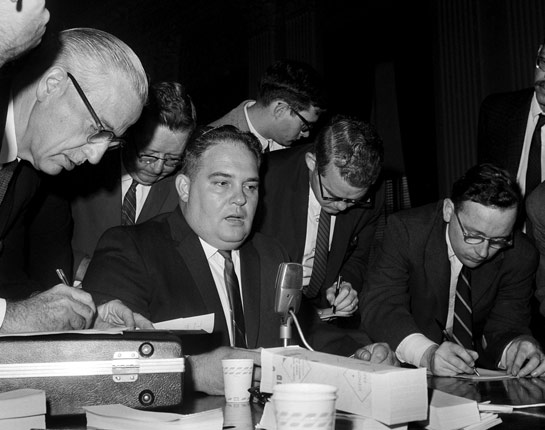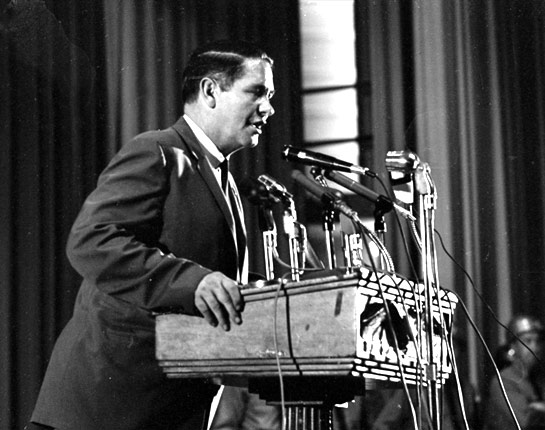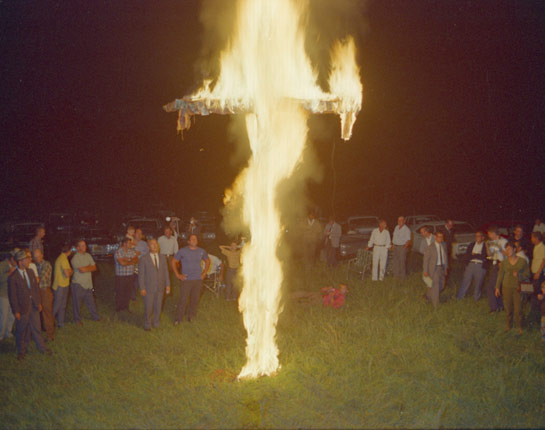The Ku Klux Klan was organized after the Civil War by a small group of men aiming to form a brotherhood during the time of Reconstruction in the 1860s. Throughout American history, the organization has come, gone and adapted with the times. In the 1960s, as lunch counter sit-ins and other civil rights demonstrations spread across the U.S., the dormant Ku Klux Klan once again began gaining momentum. That the Klan would rise once again wasn't necessarily surprising, but where the reincarnation took place was. North Carolina, long considered one of the most progressive southern states, saw a boom in Klan membership under the leadership of Bob Jones, the most influential Grand Dragon in the country. In just three years, he grew the North Carolina Klan from a handful of friends to some 10,000 members -- more than the Klans of all other southern states combined. Browse a gallery of the rise and fall of the North Carolina Ku Klux Klan -- and the man behind it.
-

Bob Jones was born in Salisbury, NC in 1930, the fifth of eight children. He joined the Navy as a young man, but was discharged for refusing to salute a black officer.
Credit: Sheila Jones Baker -

Ku Klux Klan groups marched on Washington, D.C. during their first resurgence in the 1920s. Jones' parents were active in the Klan, and Jones claimed his mother marched in a Klan parade when she was seven months pregnant with him.
Credit: Library of Congress -

Jones and his wife, Sybil, lived in Granite Quarry, NC. After leaving the Navy in the 1940s, Jones worked several odd jobs including as a lighting rod salesman.
Credit: Sheila Jones Baker -

In 1963, amidst the growing civil rights movement, Jones petitioned the United Klans of America, a nationwide Klan organization led by Robert Shelton, for a charter to organize in North Carolina.
Credit: Bruce Roberts, University of Texas -

In August 1963 Jones held his first rally as a Grand Dragon. He expected a couple hundred people to attend, but nearly 2,000 showed up.
Credit: University of North Carolina at Chapel Hill -

A rally typically wrapped up with a "cross lighting". Klan members wrapped a wooden cross in gas-soaked burlap and set it on fire. Here, Jones supervises the construction of a cross for a rally in April 1964.
Credit: Bruce Roberts, University of Texas -

By the summer of 1964, North Carolina Klan membership had grown so much that Jones bragged of his plans to hold a rally every night.
Credit: Bruce Roberts, University of Texas -

In January 1965 Jones took this photo beside his new Cadillac, a Christmas gift given to him by Klan members from across the state. He claimed that no one member was allowed to contribute more than 25 cents for the car.
Credit: Corbis -

Jones drove all across the state to set up new local chapters. By 1966, his North Carolina Klan had grown to roughly 10,000 members -- more than all other southern states' Klan groups combined.
Credit: Bruce Roberts, University of Texas -

Bob Jones' wife, Sybil was a leader in the Klan's Ladies Auxiliary and often spoke at rallies. Here, she speaks at a Salisbury, NC rally on August 8, 1964.
Credit: University of North Carolina at Chapel Hill -

George Dorsett, the official chaplain for the United Klans of America, raised tens of thousands of dollars for the organization with his powerful sermons. His skills complimented Jones', and Dorsett soon became an integral part of the North Carolina Klan.
Credit: University of North Carolina at Chapel Hill -

Klan rallies became a source of entertainment for residents in rural communities. Here, Jones stands in line for food at a rally at B.H. Ingle's church in Raleigh.
Credit: North Carolina State Archives -

Rallies weren't just for members, but also for families. According to historian David Cecelski, "Most rallies might only have 20 Klansmen, but they could have hundreds or thousands of people that were there watching and supporting."
Credit: Sheila Jones Baker -

Bob Jones hoped to make the North Carolina Klan into a political force, "so that no politician can be elected to any office without our support," he said. Here, a country string band wearing hats supporting Alabama governor George Wallace play at a Ku Klux Klan rally.
Credit: Sheila Jones Baker -

In March 1965, Alabama Klansmen murdered white housewife and activist Viola Liuzzo. Her death spurred the federal government into action against the Klan. President Lyndon Johnson warned members to "get out of the Ku Klux Klan...before it's too late."
Credit: LBJ Presidential Library -

President Johnson's warning evoked anger and resentment among North Carolina Klansmen. In a show of defiance, Jones and Dorsett hosted the Klansmen accused of killing Viola Liuzzo at a rally attended by 6,000 people on May 15, 1965.
Credit: National Archives -

Jones and his fellow Klan leaders did not hide their involvement with the group. At a 1965 wedding ceremony in Farmville, NC, they pose in full Klan garb.
Credit: Corbis -

Jones planned frequent daytime marches, like this one through downtown Raleigh on June 28, 1965, to show that his Klan had nothing to hide.
Credit: North Carolina State Archives -

By the mid-1960s, a federal agent had befriended George Dorsett, and the FBI was paying Dorsett upwards of $500 a month for informing on Jones and the UKA.
Credit: North Carolina Museum of History -

During hearings held by the House Un-American Activities Committee in the fall of 1965, Jones and other leaders sidestepped questions about Klan funds, causing suspicion to sprout among klan members. North Carolina treasurer Joseph DuBois (center) resigned on the stand claiming, "Only a Communist takes the Fifth Amendment."
Credit: Associated Press -

On August 14, 1966, in North Carolina's largest political gathering of the year, more than 5,000 people attended a United Klans of America rally to show their support for Klan leaders being investigated by the FBI.
Credit: North Carolina State Archives -

When Bob Jones addressed demonstrators at Memorial Auditorium on August 14, he was facing a possible prison sentence for contempt of Congress for refusing to hand over Klan financial records. Though his hesitance alienated some members, over 5,000 fellow Klansmen and sympathizers showed up to support Jones.
Credit: North Carolina State Archives -

In 1967, Dorsett (left) was ousted as the UKA's Imperial Kludd after he accused Klan leaders of financial mismanagement. Dorsett's federal agent confidant encouraged Dorsett to form his own Klan group, hoping to divide and therefore weaken the Klan. Dorsett did, though his group quickly fell apart.
Credit: North Carolina State Archives -

In 1969, Bob Jones entered federal custody to serve a one-year prison sentence for contempt of Congress. By that time, North Carolina Klan membership had dwindled to fewer than 1,000 active members.
Credit: Sheila Jones Baker -

A group of North Carolina Klansmen, frustrated with the UKA's financial management, split from the national group on September 15, 1969 by burning their membership cards.
Credit: University of North Carolina at Chapel Hill -

By the end of the 1960s, North Carolina Klan membership was estimated at just 500 active members. The United Klans of America remained active throughout the 1970s and '80s, but dissolved after losing a 1987 civil lawsuit put forth by the Southern Poverty Law Center.









